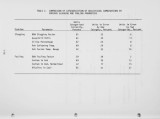| OCR Text |
Show Base to Acid Ratio Another slagging parameter that is sometimes used is the base/ acid ratio. Obviously, this parameter is closely related to the B&W slagging factor. A value for the base/acid ratio of less than 0.5 is sometimes taken to be an indicator of low slagging potential. Figure 2 shows the scatter of data when base/acid ratio and the unit area steam generation rate are used as parameters. The empirically drawn lines identify regions of rare, occasional, and frequent slagging problems. Using the regions, as defined in Figure 2, 61 percent of the data points fall in the correct regions. Silica Percentage (on Silica Ratio) (2) Reid and Cohenv ' developed the silica percentage as a factor that relates to ash viscosity for temperatures above the temperature of critical viscosity for the ash. Thus, it is most useful for evaluating ashes relative to ash flow from wet bottom units. However, the silica percentage has been used as a slagging parameter. It is defined as: Si02 Silica Percentage = Si02 + F e ^ + CaO + MgO Although no values are recommended as being regions of high slagging or low slagging, the higher silica percentages are indicative of ashes with higher melting temperatures and fewer slagging problems. Figure 3 shows the distribution of slagging data when silica percentage is used as the coal parameter. This figure shows that 67 percent of the power plants are correctly classified when the boundaries shown are used. Ash Softening Temperature (3) The ash softening temperature (spherical)v , often referred to as the ash fusion temperature, is one of the most widely used indicators of the slagging tendencies of coals. Its wide use undoubtedly is related to the greater availability of ash fusion data than other coal data. It 1-7 |






























